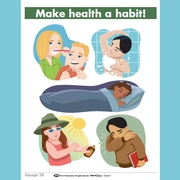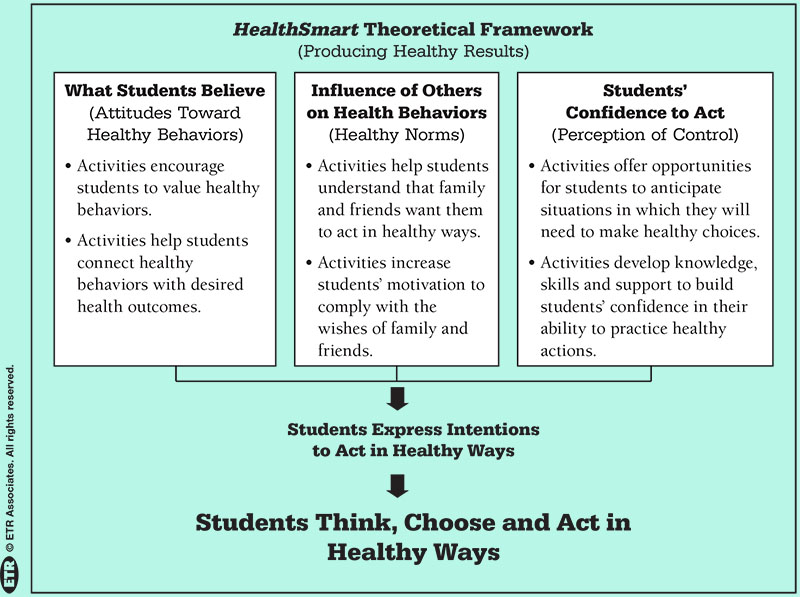HealthSmart: Putting Health Ed Research into Action - Part 2
By Suzanne Schrag | November 7, 2017
Editor/Product Manager, ETR
It’s not enough to simply teach students information about health. As health educators, we must help them master key concepts and skills that promote health literacy and lifelong health. HealthSmart, ETR’s comprehensive K–12 health education program, targets Healthy Behavior Outcomes as its primary goal. This sets HealthSmart apart from a more traditional textbook health program.
ETR strongly values the role of research and evaluation in determining the best way to promote health among young people. HealthSmart reflects this research-based approach in every lesson. The second of the 15 Characteristics of Effective Health Education Curricula defined by the CDC states that an effective program “is research based and theory driven.”
This is a great reason to look at the theoretical foundation of HealthSmart, and how it puts into action what research tells us about effective programs.
Part 1 of this series described the primary goal of HealthSmart: to impact students’ health behaviors in a positive way. In Part 3, we look at the ways HealthSmart builds competence and self-efficacy by addressing skills—thereby achieving Healthy Behavior Outcomes.
A Theory for Understanding Health Behavior
Theoretical principles woven throughout the lessons increase the likelihood that students will value and practice the healthy actions that help prevent excessive morbidity (e.g., illness, injury, emotional trauma) and premature mortality. HealthSmart lessons and activities are designed to:
- Build a personal value for health as students explore health beliefs and the potential outcomes of their health choices.
- Shape healthy peer norms when students understand the healthy actions their family and friends support and expect.
- Build power to use knowledge when students understand the concepts needed to practice healthy behaviors.
- Build power to use key skills for health literacy through guided practice.
- Increase students’ perception of control over their own health choices and behaviors as they acquire foundational knowledge, develop skills and establish support systems.
The activities are also designed to promote a constructivist approach to learning. This means students engage in active learning through observation and interaction with others as they explore a problem, try out solutions and build on their knowledge to make adjustments.
So, how does all of this theory look in action? Let’s go back to the very first characteristic of effective health education: An effective program “focuses on clear health goals and related behavioral outcomes.” The primary goal of HealthSmart is to impact students’ health behaviors in a positive way. Achieving those Healthy Behavior Outcomes defined by CDC—the things students should be able to do by the time they graduate in order to be health literate—drives the instruction throughout every grade level.
Functional Knowledge Is Key
From the characteristics of effective health education curricula, we also know that an effective program “provides functional health knowledge that directly contributes to health-promoting decisions and behaviors.” What do we mean by “functional” health knowledge? This refers to those facts and concepts that are essential to making healthy decisions and practicing health-enhancing behaviors.
For example, learning about the circulatory system is interesting, but it isn’t really going to help address the health risk of inadequate physical activity. On the other hand, knowing that activities that make your heart beat faster and your lungs breathe harder help you stay healthy, and then setting a goal to be active for 60 minutes a day, can make a difference. These concepts and this skill contribute directly to the healthy behavior outcomes of (1) regularly engaging in physical activities that enhance cardio-respiratory endurance, and (2) following a physical activity plan for healthy growth and development.
In building HealthSmart, we made distinctions between need to know and nice to know. Need to know is that functional knowledge presented by effective programs—for example, kids need to move for 60 minutes a day. Nice to know is just that—of interest, both now and in the future—but not essential to the practice of a healthy behavior. An example would be a map of the circulatory system or a lecture about how many chambers the heart has.
Skills Matter Too
The other key piece of the puzzle is learning and practicing the skills that will support healthy behaviors. Looking to the characteristics again, we see that an effective program “builds competence and self-efficacy by addressing skills.” In addition to comprehending concepts, the National Health Education Standards set age-appropriate performance indicators for seven essential health skills:
- Analyzing Influences
- Accessing Information
- Interpersonal Communication
- Decision Making
- Goal Setting
- Practicing Health-Enhancing Behaviors
- Advocacy
Step-by-Step to Skill Development
The HealthSmart program follows a research-based approach to skills development. In the development of the second edition, we paid special attention to how to best break down and teach a skill, starting at the earliest grade levels. The performance indicators from the National Health Education Standards support this progression and gradual deepening of skill development throughout the K–12 grade span.
HealthSmart uses a step-by-step approach to skills development:
- First, the educator will introduce the skill and help students relate it to their lives through examples.
- The educator will next present the sequential and specific steps for the successful performance of the skill.
- Then the educator will model of each of the steps and the entire skill sequence. This is a key component of skills development that is often overlooked.
- After seeing the skill sequence modeled, students have an opportunity for guided practice of the skill. Depending on the skill involved, this might be through structured roleplays, large-group discussion of a specific example, or small-group work.
- Finally, students are encouraged to practice the skill in situations that mirror real life, followed by feedback, reinforcement and discussion of successes and challenges.
HealthSmart offers students numerous opportunities for skills development to build confidence in their ability to practice healthy behaviors and negotiate risky situations.
In a future post, we’ll take a look at examples that show how functional knowledge and skills are taught in the newly updated second edition of the HealthSmart K–5 program.
Check It Out
If you’re intrigued by the HealthSmart approach and would like to learn more about this comprehensive, research-based, standards-aligned K–12 health education program, visit the HealthSmart website. You can also email or call ETR at 1-888-220-9455 to set up review access to the digital edition of the program.
Suzanne Schrag is an Editor and Product Manager at ETR. She is the HealthSmart series editor and one of the authors of the new second edition of HealthSmart K–5. She can be reached at schs@etr.org.






